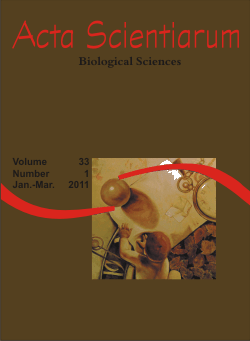<b>Soil seed bank during succession at an abandoned pasture in the upper Paraná river-floodplain, Brazil</b> - doi: 10.4025/actascibiolsci.v33i1.6391
Resumo
We evaluated density and species composition of the soil seed bank in active pasture and in secondary forest on a 10 year-old abandoned pasture to identify changes in density, richness, diversity and species composition during secondary succession of abandoned pastures. The implications of those changes for the forest recovery process were also considered. Soil samples were collected at Porto Rico island, state of Paraná, in 2007. The seedling emergence method was used. Data on active pasture collected in 1996, published by Campos and Souza (2003) were used for comparative analysis. No evidence was found of a pattern of changes in density of the soil seed bank during succession of abandoned pastures. We observed increases in richness and diversity, in the contribution of tree and shrub species and dominance of herb species for the seed bank during the first 10 years of abandonment of pastures in riparian forests. At the end of succession, the soil used as pasture can result in systems that are different from the original environment, due to seed bank impoverishment and presence of exotic species.Downloads
DECLARAÇÃO DE ORIGINALIDADE E DIREITOS AUTORAIS
Declaro que o presente artigo é original, não tendo sido submetido à publicação em qualquer outro periódico nacional ou internacional, quer seja em parte ou em sua totalidade.
Os direitos autorais pertencem exclusivamente aos autores. Os direitos de licenciamento utilizados pelo periódico é a licença Creative Commons Attribution 4.0 (CC BY 4.0): são permitidos o compartilhamento (cópia e distribuição do material em qualqer meio ou formato) e adaptação (remix, transformação e criação de material a partir do conteúdo assim licenciado para quaisquer fins, inclusive comerciais.
Recomenda-se a leitura desse link para maiores informações sobre o tema: fornecimento de créditos e referências de forma correta, entre outros detalhes cruciais para uso adequado do material licenciado.












1.png)




3.png)













